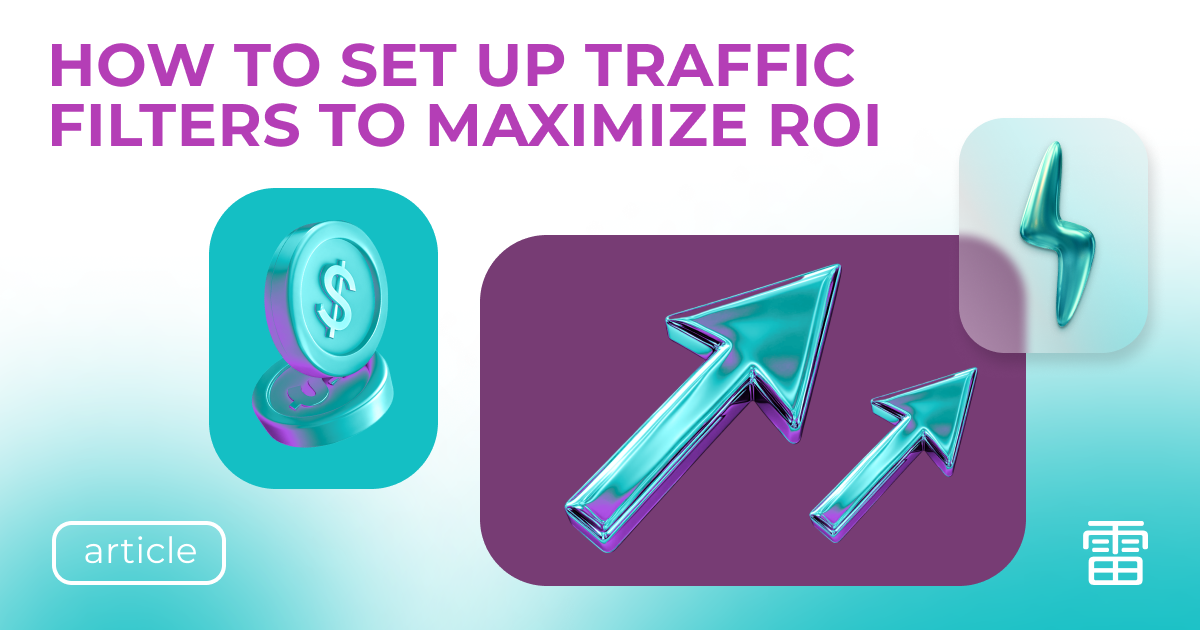Introduction
For ad networks, traffic quality plays a key role in increasing campaign effectiveness and achieving maximum ROI. However, filtering traffic at the level of individual campaigns and sources often becomes a challenge due to a lack of flexibility and complex settings. In this article, we will explore how to properly configure traffic filters, considering various formats and evaluation models, and discuss the integration of automated solutions.
1. Why Traffic Filtering is Important for Ad Networks
Traffic filtering helps ad networks:
- Avoid fraudulent and low-quality traffic.
- Improve the accuracy of source evaluation.
- Optimize advertising costs.
- Increase conversion rates through precise targeting.
However, the filtering process must be flexible and account for the characteristics of different ad formats. For example, push notifications require separate evaluation parameters distinct from pop traffic.
2. Key Steps for Setting Up Traffic Filters
2.1. Defining Key Quality Indicators
Before configuring filters, it is necessary to determine which metrics will help assess traffic quality. The main parameters include:
- CTR (Click-Through Rate) – clickability metric.
- CR (Conversion Rate) – conversion rate.
- Bounce Rate – percentage of bounces.
- Average Session Duration – average session duration.
- Engagement Metrics – user behavior after clicking.
- Fraud Indicators – suspicious activity (bots, proxies, click farming).
2.2. Setting Filters at the Campaign and Source Level
- Geo-Filtering – excluding countries with low-quality traffic.
- Device and OS Filtering – targeting specific devices and operating systems.
- User Behavior Filtering – setting filters based on engagement depth.
- IP Filtering – excluding suspicious IP ranges (VPN, proxy, data centers).
- Traffic Source Filtering – blocking unwanted publishers and sub-sources.
2.3. Automating Filtering via API
To increase efficiency, ad networks can use API solutions for real-time automated filtering and traffic evaluation. Integration with the Kaminari Click platform enables:
- Pre-set filters for different traffic formats.
- Automated analysis of sources and sub-sources.
- Configuring triggers to block suspicious IP addresses and bots.
- Detailed traffic quality reports.
3. Flexible Filters for Different Traffic Formats
3.1. Push Notifications
For push traffic, key factors include:
- Click frequency per user.
- Interaction with the landing page (time on page, scrolls, clicks).
- Differences in traffic quality between new and returning subscribers.
3.2. Pop Traffic
Pop traffic has high engagement but requires strict filtering:
- Excluding low-quality aggregator sites.
- Evaluating user activity duration on the landing page.
- Blocking bots through behavioral analysis.
3.3. Display and Native
For these formats, important considerations include:
- Ad visibility (Viewability Rate).
- Interaction with creatives (viewing time, scrolls, clicks).
- Suspicious behavioral patterns (e.g., instant clicks).
4. Improving the Filter Setup Process
4.1. Ready-Made Presets for New Clients
To simplify the setup process for new clients, pre-configured filter templates can be used, such as:
- Standard Preset – filters for geo, devices, and sources.
- Anti-Fraud Preset – advanced IP analysis, behavioral patterns.
- Optimized Preset – settings tailored for specific traffic formats.
4.2. Training Ad Network Staff
Ad networks often face a lack of knowledge about proper filtering setup. To address this issue, they can:
- Conduct webinars and training sessions.
- Create detailed filter configuration guides.
- Provide individual consultations for clients.
5. Analyzing User Behavior to Identify Ineffective Traffic
Analyzing user behavior helps:
- Identify sources that provide the highest quality traffic.
- Exclude low-performing campaigns.
- Improve targeting and ad personalization.
Key metrics for analysis include:
- Heatmaps – identifying which elements of the site attract the most attention.
- Scroll Depth – how far users scroll down the page.
- Event Tracking – tracking user actions (clicks, form submissions, etc.).
Conclusion
Traffic filtering is a crucial process for ad networks, allowing them to minimize fraud, optimize costs, and increase ROI. Using flexible settings, automating filtering through APIs, and analyzing user behavior are three key elements to achieving maximum advertising campaign efficiency.
The Kaminari Click platform offers powerful tools for analyzing and filtering traffic, ensuring protection from bots and low-quality sources. Investing in proper filter configuration enables ad networks to significantly improve campaign performance and profitability.
Ready to enhance your traffic quality and ROI? Contact us, and we will help you configure filtering for maximum efficiency!

